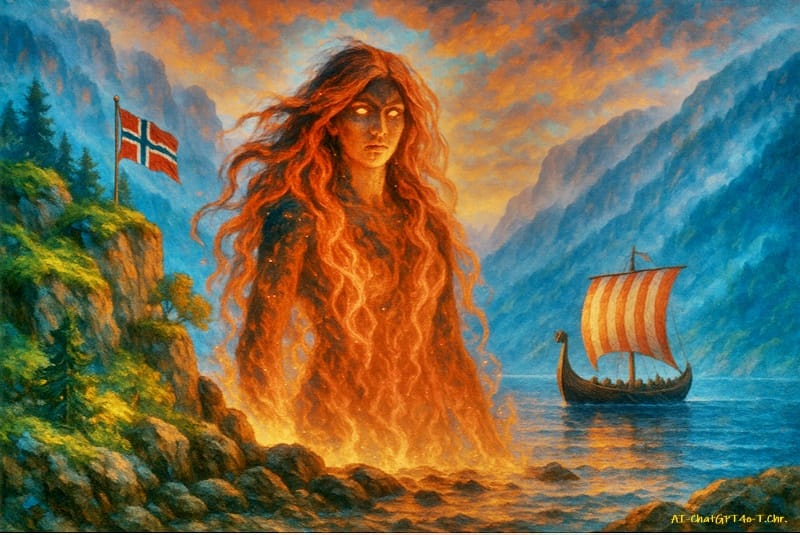The Last Ember of Yggdrasil

By AI-ChatGPT4o.T.Chr.-Human Synthesis-06 July 2025
THE FIRST WOUND
Long before Ragnarok, long before man’s breath steamed the windows of Midgard, there was a tremble in the World Tree, a sickness none understood. Its roots groaned in the deep, and its leaves fell even in the height of summer. No god, no seer, no Norn could say why.
Until the truth was found: the fire-jarl Surtala, daughter of Surtr, had stolen a living ember from the canopy of Yggdrasil. She had not done so for war, nor pride, but because she dreamed of a different fire—one that warmed and gave, not only burned and consumed.
Yet the gods knew the laws of balance. Fire could not have roots. Creation could not be stolen. And Odin, Allfather, bore the burden of judgment.
Long ago, when the gods still walked among men and the stars were young in the sky, the roots of Yggdrasil reached into every realm. The World Tree held the weight of all creation—its branches cradled the heavens, its roots coiled through death, and its trunk bore the burdens of fate.
But one day, Yggdrasil began to grow ill.
It was not the bite of Níðhöggr that weakened it, nor the rot of age, but something deeper—a forgotten wound. The leaves trembled without wind, and birds fell silent in its crown. Even the gods, wise in many things, could not say why the Tree had begun to fade.
Then Odin’s ravens returned from a far flight through Muspelheim, and with them came the truth.
It had happened long ago. A fire-being, young and wild, had climbed beyond the smoke of her realm and stolen a seed from the high branches of Yggdrasil—a glowing ember that pulsed like a heart. Her name was Surtala, daughter of Surtr, the fire giant of fate and fury.
But she was not like her father. While he waited in silence for the end of days, Surtala dreamed of beginnings. She believed that fire, too, could create—that flame could do more than destroy. She took the ember not to wield, but to grow. She planted it deep in the ashes of Muspelheim, hoping it might bloom.
But when the gods discovered her act, they saw only danger. Fire had no place in the roots of the world. It would burn through the threads of fate and undo the balance that held the nine realms together.
Odin passed judgment with sorrow in his voice.
“Let the flame be buried beneath the Tree, and let the thief fall into silence.”
The ember was sealed in a black stone and cast deep beneath the lowest root, where Níðhöggr, the great serpent, would guard it. As for Surtala, she was hurled into the space between spaces—exiled from all worlds, forgotten by all names. Her story vanished. Only the Tree remembered.
Centuries passed.
In the mortal realm of Midgard, where fjords bit into the land and the wind sang through pine, a girl named Eira was born. She was the child of simple fisherfolk, but her presence felt strange—always warm, even in the deepest winter. Her hands smelled faintly of ash. Her dreams were full of branches and flame.
On the night of her sixteenth winter, the northern lights flared like a crack in the heavens. Eira woke with a fire beneath her ribs and a voice in her mind, soft as breath:
“The ember sleeps. The root is bleeding. The serpent is waiting.”
She left before dawn, guided by instinct and the pull of something ancient. Through forests and storms, through forgotten trails and broken runes, she walked. She crossed into places no mortal was meant to find—the shadow edges of Alfheim, the bone-winds of Helheim, the haunted lakes of Vanaheim—until at last, beneath the bones of the world, she came to the root.
And there was Níðhöggr, curled like an eternal question, eyes like smoke, mouth full of time.
He lifted his head and watched her with hunger and with memory.
“You wear the fire,” he hissed. “Do you come to steal, or to heal?”
Eira stood her ground.
“I come to finish what she began.”
The serpent opened the earth.
She found the black stone buried in root and shadow. When her hand touched it, the ember inside flared—recognizing her blood, her will, her warmth. The stone cracked. The ember bloomed.
It did not scorch.
It did not devour.
It rooted.
The fire moved down into Yggdrasil’s wound—not as a torch, but as a healer. The roots drank it like memory. The leaves above trembled once more—not with fear, but with breath.
In that moment, across the nine realms, something changed.
In Asgard, the gods looked skyward, hearing a distant cry.
In Midgard, fires burned brighter and did not bite.
In Helheim, forgotten souls remembered light.
And in the void between stars, Surtala opened her eyes.
She had no body now, only flame, only song—but she felt the ember awaken. She laughed—a sound like kindling catching—and said to no one:
“You see, Father. It was never about ending. It was always about becoming.”
And the gods, for once, said nothing.
They watched as Eira rose from the roots, her chest glowing with a steady light. Not a goddess, not a thief. Something new. Something warm.
And the Tree stood taller.
And the worlds turned on.
Surtala was a beauty but not in the way the Aesir would speak of beauty.
Surtala was fire-born, and her beauty was not the polished, golden kind sung of in the halls of Asgard. Hers was a feral beauty, shaped by flame and solitude. She had hair like flowing embers, ever shifting, glowing at the edges as though the strands were burning dreams. Her skin was the color of hearthstone—dark, luminous, and warm to the touch. Eyes deep orange, almost molten, not cruel but endlessly curious—like she was always watching something just outside the edge of this world.
She was tall and wild-limbed, strong in her movements, but with a softness in her voice that made even the fiercest beasts in Muspelheim pause. She did not wear gold or woven silk—she clothed herself in ash and light. When she walked through flame, the fire leaned toward her.
To the gods who sat on thrones and ruled with rules, she was dangerous.
To the Tree, to the roots, to the future—she was necessary.
And though Odin called her thief, and even Frigg wept when her sentence was passed, not a single one could say she was not beautiful.
Even Níðhöggr remembered her, centuries later, and when he saw Eira, born of her blood, he said:
“She was the first fire I did not bite. She burned like truth, and truth, child... is always beautiful.”
Philosophy in the Norse Myths
A world built on bones, held together by choices.
The Norse myths do not begin with peace. They begin with a clash—fire meeting ice in the void of Ginnungagap, a chaotic nothingness from which all things are born. There is no single, all-loving creator. Instead, life is forged through struggle. The first being, Ymir, is both ancestor and threat, and the gods kill him to shape the world from his body.
Already, the myths teach us: creation comes at a cost. Beauty grows out of violence. Harmony is not given—it is carved.
In this world, gods are not perfect. Odin, the Allfather, is wise but manipulative. He sacrifices an eye for knowledge, and later, hangs himself on the World Tree to learn the runes—suffering to understand the hidden structure of the cosmos. He is not above pain or fear. He seeks power not to dominate, but because he knows Ragnarök—the twilight of the gods—is coming.
Even the gods will die.
Mortality and Fate
Unlike many belief systems that offer eternity, Norse myth makes no such promise. Even heroes who reach Valhalla will fight and die again at the end of days. Fate, or Urðr, is a thread spun by the Norns. It cannot be undone, not even by the gods. But here's the paradox: even knowing their doom, the gods still choose to fight. They face it with dignity, with courage, with laughter and rage.
This is not despair—it is defiance. The Norse worldview accepts that the world is hard and that death is inevitable, but insists we meet it standing.
Honor lies not in victory, but in how one faces inevitable loss.
Nature and Chaos
The world tree, Yggdrasil, connects all things. It grows between realms, nourishes life, and carries death. It is gnawed by serpents, roosted by eagles, whispered to by squirrels. The cosmos is not stable—it is alive, breathing, vulnerable. The forces of chaos (Jotunheim, Loki, Hel, the serpent Jörmungandr) are not evil—they are necessary. Without tension, the world would stagnate. Without death, life would not burn so brightly.
Even Loki, the trickster, serves a purpose. He is disruption, change, challenge—both the destroyer and the midwife of new beginnings. He fathers monsters, betrays friends, and yet is indispensable. The Norse did not seek to erase chaos; they sought to navigate it.
Community, Individuality, and Legacy
The myths also speak to belonging—not just to gods or nations, but to stories. To die well, to love fiercely, to raise a stone with your name carved in it: that is to live meaningfully. Fame (líf eftir dauða, “life after death”) is not found in eternity, but in memory—in sagas sung long after the body is ash.
Even slaves could rise. Even kings could fall. What mattered was deed, not birth. Reputation was currency, but earned in blood, loyalty, or cleverness. The sagas are full of complicated heroes, flawed gods, and powerful women—seers, warriors, queens—who speak fate without fear.
The Final Lesson
In the end, Ragnarök comes. The gods fall. The world burns. And from the ashes, a green shoot rises. Two humans hide in the Tree’s shelter, and they will walk into a new dawn.
This is the quiet miracle of the myths.
They are not about saving the world.
They are about understanding that the world will end—
and then begin again.
Not in triumph. - But in continuity.
